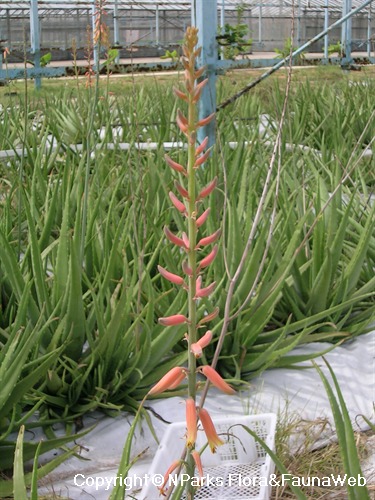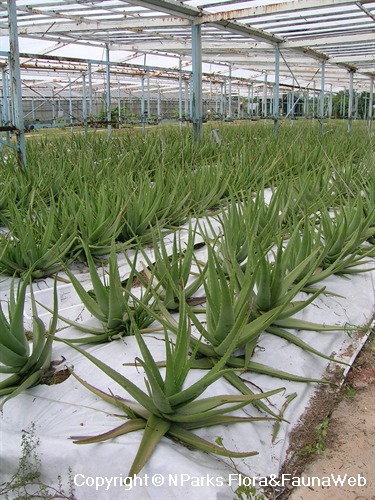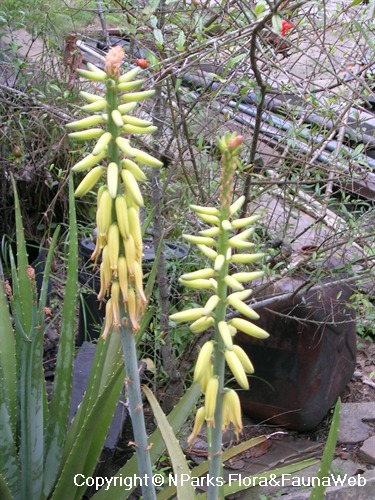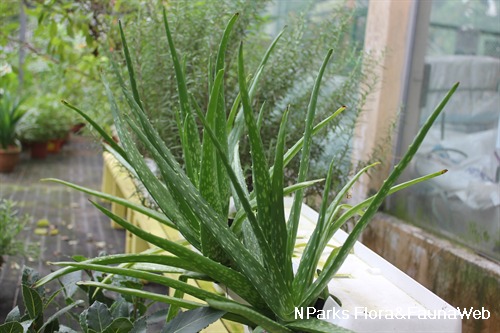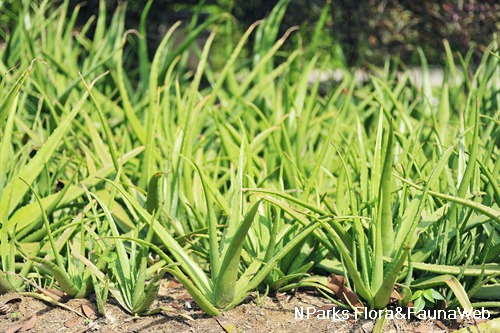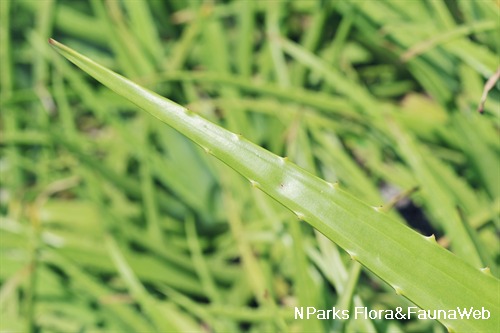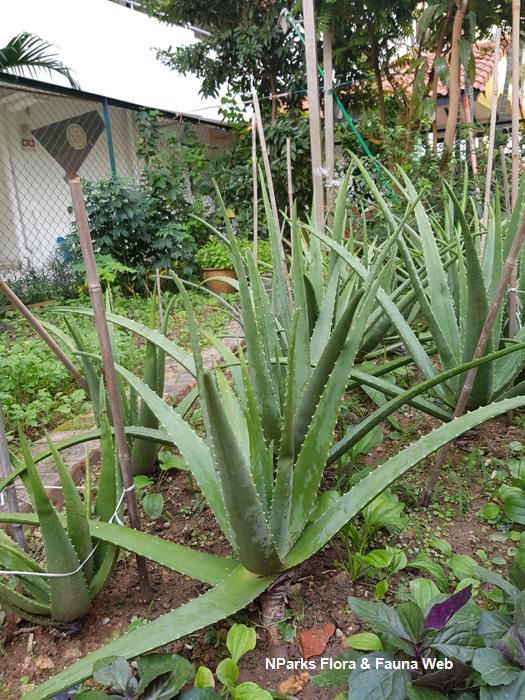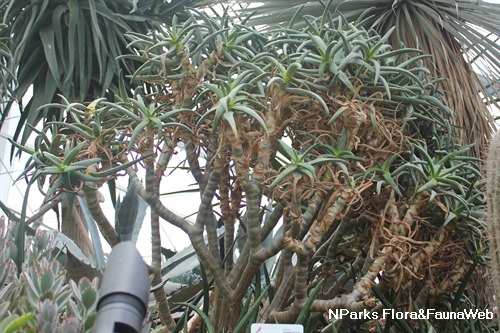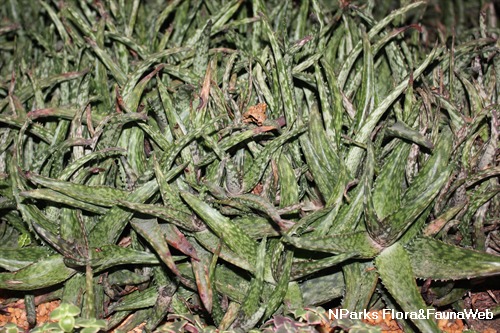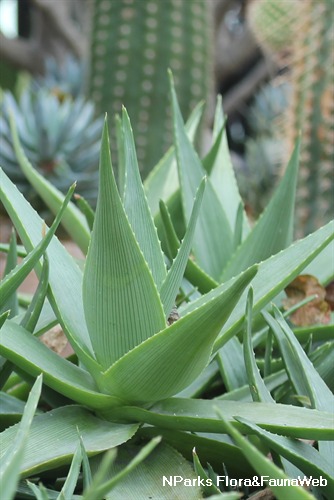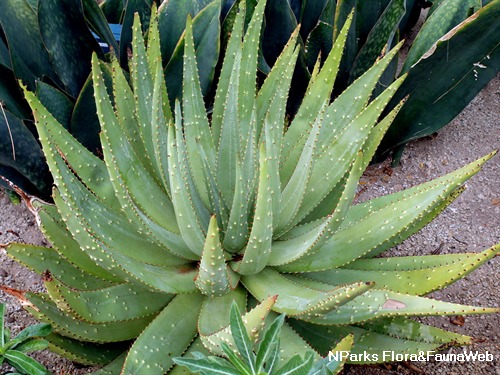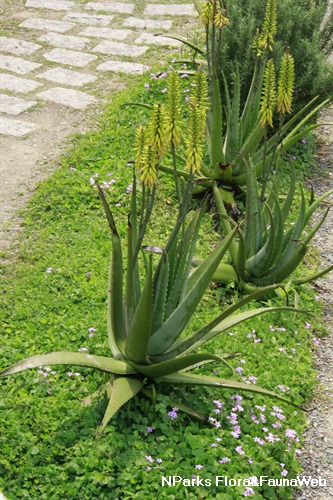
Back
Aloe vera (L.) Burm.f.
| Family Name: | Asphodelaceae |
| Synonyms: | Aloe perfoliata var. vera L. |
| Common Name: | Aloe, Barbados Aloe, Medicinal Aloe, Burn Plant, 芦荟 |
Name
Classifications and Characteristics
| Plant Division | Angiosperms (Flowering Seed Plants) |
|---|---|
| Plant Growth Form | Succulent Plant |
Biogeography
| Native Distribution | Oman |
|---|---|
| Native Habitat | Terrestrial (Mountain) |
| Local Conservation Status |
Description and Ethnobotany
| Growth Form | Succulent herb typically growing up to 0.3-0.6 m tall, but sometimes reaching 1.2 m tall. |
|---|---|
| Roots | The roots form a mutually beneficial relationship with arbuscular mycorrhiza fungi which live inside the roots. The fungi helps the plant to extract soil nutrients over a larger area than the plant has access to, while the plant feeds the fungi with carbohydrates, lipids and nutrients. |
| Foliage | Fleshy, triangular leaves (up to 0.9 m long) are arranged in a rosette. Light green leaves with white spots are smooth with a spiny leaf margin. |
| Flowers | Yellow, tubular flowers are arranged in a spike inflorescence. |
| Habitat | In Oman, Aloe vera occurs at altitudes of 1300 to 2600 m in dry, rocky and/ or exposed places. |
| Cultivation | Aloe vera grows best under direct sun in well-drained, porous soil, but it also tolerates light shade. In Singapore, it grows well in pots that are sheltered from the rain. It is susceptible to fungal disease, so try to keep the leaves dry and keep soil from splashing on the leaves. |
| Ethnobotanical Uses | Edible Plant Parts : Edible Leaves Medicinal: Scientific Evidence of Medicinal Properties In pre-clinical and clinical trials, Aloe showed anti-diabetic (Huseini et al., 2012), antioxidant (Prueksrisakul et al., 2015), and cholesterol-lowering properties (Huseini et al., 2012) in animals and people. In pre-clinical trials, Aloe showed pain-relieving (Egesie et al., 2013), anti-cancer (Saini et al., 2010), anti-inflammation (Egesie et al., 2013) and anti-microbial properties (Hussain et al., 2017) in animals. Traditional Medicinal Uses Research supports the traditional use of Aloe to treat wounds. The leaves contain a clear gel that is applied to minor cuts and burns to promote healing. Other traditional uses of Aloe include treating constipation. It is important to note that some therapeutic effects from traditional medicinal uses of plants are not currently supported or verified by scientific research.
Others: The leaves contain a gel that is added to skin moisturizers. |
Landscaping Features
| Landscape Uses | Container Planting |
|---|---|
| Thematic Landscaping | Economic Garden |
| Usage Hazard - Cons | Spines/Thorns - Leaf |
Plant Care and Propagation
| Light Preference | Full Sun |
|---|---|
| Water Preference | Little Water |
| Rootzone Tolerance | Easy to Grow, Drought Tolerant, Well-Drained Soils |
| Propagation Method | Sucker |
Foliar
| Foliage Retention | Evergreen |
|---|---|
| Mature Foliage Colour(s) | Green |
| Mature Foliage Texture(s) | Smooth, Thick |
| Foliar Type | Simple / Unifoliate |
| Foliar Arrangement Along Stem | Rosulate / Rosette |
| Foliar Attachment to Stem | Sessile |
| Foliar Shape(s) | |
| Foliar Venation | Parallel |
| Foliar Margin | Serrate / Toothed |
| Foliar Apex - Tip | Acuminate |
| Foliar Base | Truncate / Square |
| Typical Foliar Area | Mesophyll ( 45cm2 - 182.25 cm2 ) |
| Leaf Area Index (LAI) for Green Plot Ratio | 3.5 (Shrub & Groundcover - Monocot) |
| Typical Foliar Size | 0.5 m |
Floral (Angiosperm)
| Flower & Plant Sexuality | Bisexual Flowers |
| Flower Colour(s) | Yellow / Golden |
|---|---|
| Flower Grouping | Cluster / Inflorescence |
| Flower Location | Terminal |
| Individual Flower Shape | Tubular |
| Inflorescence Type | Spike |
References
| References | Egesie, U.G., Chima, K.E. & Galam, N.Z. (2011). Anti-inflammatory and analgesic effects of aqueous extract of Aloe vera (Aloe barbadensis) in rats. African Journal of Biomedical Research 14: 209–212. Huseini, H.F., Kianbakht, S., Hajiaghaee, R. & Dabaghian, F.H. (2012). Anti-hyperglycemic and anti-hypercholesterolemic effects of Aloe vera leaf gel in hyperlipidemic type 2 diabetic patients: A randomized double-blind placebo-controlled clinical trial. Planta Med 78(4): 311–316. Hussain, S.A., Patil, G.R., Reddi, S., Yadav, V., Pothuraju, R., Singh, R.R.B. & Kapila, S. (2017). Aloe vera (Aloe barbadensis Miller) supplemented probiotic lassi prevents Shigella infiltration from epithelial barrier into systemic blood flow in mice model. Microbial Pathogenesis 102: 143–147. Klaikeaw, N., Wongphoom, J., Werawatganon, D., Chayanupatkul, M. & Siriviriyakul, P. (2020). Anti-inflammatory and anti-oxidant effects of Aloe vera in rats with non-alcoholic steatohepatitis. World Journal of Hepatology 12(7): 363–377. Prueksrisakul, T., Chantarangsu, S. & Thunyakitpisal, P. (2015). Effect of daily drinking of Aloe vera gel extract on plasma total antioxidant capacity and oral pathogenic bacteria in healthy volunteer: A short-term study. Journal of Complementary and Integrative Medicine 12(2): 159–164. Rajasekaran, S., Ravi, K., Sivagnanam, K. & Subramanian, S. (2006). Beneficial effects of Aloe vera leaf gel extract on lipid profile status in rats with streptozotocin diabetes. Clinical and Experimental Pharmacology and Physiology 33:232–237. Rajasekaran, S., Sivagnanam, K. & Subramanian, S. (2005). Antioxidant effect of Aloe vera gel extract in streptozotocin-induced diabetes in rats. Pharmacological Reports 57:90–96. Saini, M.R., Goyal, P.K. & Chaudhary, G. (2010). Anti-tumor activity of Aloe vera against DMBA/ croton oil-induced skin papillomagenesis in Swiss albino mice. Journal of Environmental Pathology, Toxicology and Oncology 29(2):127–135 |
|---|
Image Repository
Others
| Master ID | 347 |
|---|---|
| Species ID | 1643 |
| Flora Disclaimer | The information in this website has been compiled from reliable sources, such as reference works on medicinal plants. It is not a substitute for medical advice or treatment and NParks does not purport to provide any medical advice. Readers should always consult his/her physician before using or consuming a plant for medicinal purposes. |

